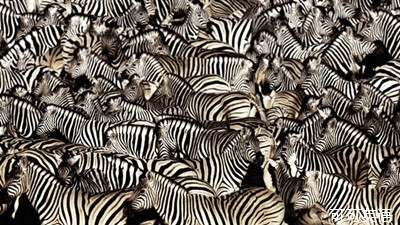(单词翻译:单击)
中英文本
Science and technology
科学技术
Why zebra are striped
为啥斑马身上是条纹
Horse sense
马识
Are zebra stripes just an elaborateinsect repellent?
斑马身上的斑纹只是精致的驱虫器吗?
Imagine what it looks like to a fly
想象一下这在蝇的眼里是幅什么样的画面

HOW the zebra got his stripes sounds like the title of one of RudyardKipling's Just So stories.
斑马为什么会长条纹捏这听上去有点像Rudyard Kipling的书《原来如此》里面文章的标题。
Sadly, it isn't, so the question has, instead,been left to zoologists.
可惜啊,这不是其中的标题,所以这个问题的答案就成了动物学家的任务。
But they, too, have let their imaginations rip. Somehave suggested camouflage.
然而,这些动物学家们也是天马行空。一些人认为是保护色。
Others suggest they are a way to display anindividual's fitness.
其他人则认为条纹是一种个体属性的彰显方式。
Irregular stripes would let potential mates know thatsomeone was not up to snuff.
不规则的条纹给潜在伴侣传递出不达标的信息。
One researcher proposed that stripes are to zebrawhat faces are to people,
有位研究人员认为斑马的条纹就像人的脸一样,
allowing them to recognise each other, since everyanimal has a unique stripe-print.
由于每个斑马的条纹都独一无二,可以让同类彼此辨认。
Another even speculated that predators mightget dizzy watching a herd of stripes gallop by.
还有些人甚至认为捕食者看到一群条纹在面前飞奔会晕头转向。
There is,however, one other idea: that stripes are a sophisticated form of flyrepellent.
但是还有这样一种想法:条纹是一种精致的防蝇器。
It was originally dreamed up in the 1980s, but never proved.
这种想法产生于20世纪80年代,但是从未被证明。
Now, ateam of investigators led by Gabor Horvath of Eotvos University in Budapestreport in the Journal of Experimental Biology thatthey think they have done so.
现在,由坐落于Budapest的Eotvos大学的Gabor Horvath带领着一组研究人员在《实验生物学报》上发表了一篇论文认为他们证明了这一想法。
The original suggestion was that stripes repel tsetse flies.
原本的猜想是说条纹是为了避免舌蝇。
These insectscarry sleeping sickness, which is as much a bane of ungulates as it is of people.
这些小昆虫带有昏睡病,对人类和有蹄类动物同样致害。
But tsetses are not the only dipteran foes of zebra and,
但是舌蝇并非是斑马唯一的长着翅膀的敌人,
since they arerarely found in the meadows of Hungary,
因为舌蝇在匈牙利的草原上并不常见。
Dr Horvath plumped for studying analmost equally obnoxious alternative: the horsefly.
Horvath转而研究一种同样恼人的替代品:马蝇。
Horseflies, too, transmit disease.
马蝇也同样传播疾病。
They also bite incessantly, thuskeeping grazing beasts from their dinner.
它们属于寄生式叮咬,因此使得这些动物进食减少。
Indeed, previous research has shownthat fly attacks on horses and cattle reduce their body fat and milkproduction.
的确有研究表明被马蝇袭击的马和牛出现了身体脂肪和产奶量下降的现象。
Such research has also shown something odd:
这些研究还出现了一些奇怪的现象:
horseflies attack blackhorses in preference to white ones.
相对于白马,马蝇更喜欢叮咬黑马。
That fact got Dr Horvath wondering how theywould react to a striped horse—in other words, a zebra.
这一事实使得Horvath博士十分好奇马蝇会对一个条纹马,也就是斑马作何反应。
Actual zebra are hard to experiment on.
很难对真实的斑马做实验。
They insist on moving around andswishing their tails.
它们一直在动来动去并且甩着尾巴。
The team therefore conducted their study using inanimateobjects.
因此这组研究人员用非生命体来进行实验。
Some were painted uniformly dark or uniformly light,
一些实验对象被涂成纯白色或者纯黑色,
and some hadstripes of various widths.
还有一些则被涂成宽度各异的条纹图案。
Some were plastic trays filled with salad oil.
其中有些是充满色拉油的塑料架子。
Some were glue-covered boards. And some wereactual models of zebra.
一些是胶合纸板做的。还有一些是真实的斑马。
They put these objects in a field infested withhorseflies and counted the number of insects they trapped.
他们把这些实验对象放到一个充满马蝇的场地,然后计算被吸引的马蝇数目。
Their first discovery was that stripes attracted fewer flies than solid,uniform colours.
他们第一个发现是条纹的比纯色的吸引的马蝇少。
As intriguingly, though, they also found that the leastattractive pattern of stripes was precisely those of the sort of width found onzebra hides.
然而,耐人寻味的是他们还发现吸引力最小的条纹花式正是斑马身上的条纹样式。
Zebra stripes do, therefore, seem to repel horseflies.
因此,斑马的条纹看起来真的能够防马蝇。
Exactly why is unclear.
至于为什么会这样还是个谜团。
But Dr Horvath thinks it might be related to a horsefly'sability to see polarised light,
但是Horvath博士认为这可能与马蝇识别偏振光的能力有关,
which imposes a sense of horizontal andvertical on an image.
偏振光是从水平和垂直方向打在画面上的。
Horseflies are known to prefer horizontal polarisedlight.
众所周知马蝇偏向于水平偏振光。
Possibly, the mostly vertical stripes on a zebra confuse the fly's tinybrain and thus stop it seeing the animal.
所以极有可能是斑马身上垂直的条纹迷惑了马蝇的小脑袋,因此阻碍了马蝇发现斑马。
Another obvious question, though, is why other species have not evolvedthis elegant form of fly repellent,
然而,还有一个显而易见的问题就是为什么其他的物种没有进化出来这种精致的防蝇方式,
and what the consequences would have beenif they had.
以及如果其他物种也进化成这样的后果。
If humans, for example, were black-and-white striped,
例如,如果人类是黑白条纹的,
then thehistory of intercommunal violence the species has suffered when different raceshave met might not have been quite as bad.
那么当不同种族相遇而遭受的两族间的暴力历史或许也没那么坏。
One for Kipling to have pondered,perhaps?
这也许是Kipling需要思考的一个问题?
词语解释
1.a herd of 一群
A herd of bighorn sheep joined us for breakfast.
一群加拿大盘羊和我们一起吃了早餐。
You gotta mouth like a herd of boll weevils.
你有一个像一群棉子象鼻虫一样的嘴巴。
2.dream up 想起,想象出
I had to give my dream up.
我不得不放弃我的梦想。
I wonder what excuse they will dream up tomorrow.
我寻思他们明天会想出什么借口。
3.react to 对…作出反应
In the next few days, markets will react to the changed outlook.
未来几天,市场将顺应形势的变化而作出反应。
Iran didn't immediately react to huawei's announcement.
伊朗没有立即对华为的声明做出反应。
4.fill with 装满
Your lungs become leaky and fill with fluid.
肺部开始渗漏,充满液体。
Select the cells that you want to fill with a pattern.
选择要用图案填充的单元格。


